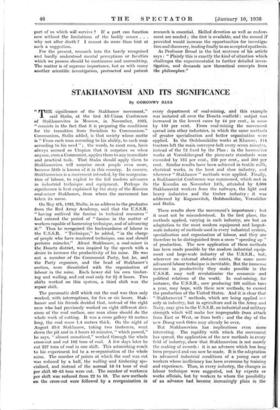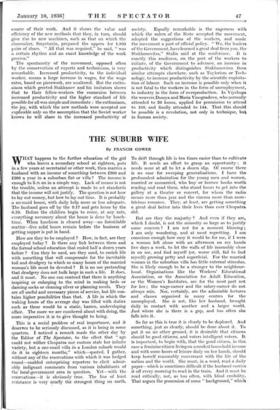STAKHANOVISM AND ITS SIGNIFICANCE
By GORON'IVY REES
"THE significance of the Stakhanov movement," said- Stalin, at the first All-Union Conference of Stakhanovites in Moscow, in November, 1935, " consists in the fact that it is preparing the conditions for the transition from Socialism to Communism." Communism, Stalin added, is that society whose motto is " From each man according to his ability; to each map according to his need " ; the words, to most men, have always seemed so Utopian that it surprises us when anyone, even a Communist, applies them to any immediate and practical task. That Stalin should apply them to Stakhanovism will surprise most people even more, because little is known of it in this country. In essence, Stakhanovism is a movement intended, by the reorganisa- tion of labour, to exploit to the full modern advances in industrial technique and equipment. Perhaps its significance is best explained by the story of the Russian coal-miner Stakhanov, from whom the movement has taken its name. . .
On May 4th, 1935, Stalin, in an address to the graduates from the Red Army Academy, said that the U.S.S.R. " having outlived the famine in technical resources " had entered the period of " famine in the matter of workers capable of harnessing technique, and of advancing it." Thus he recognised - the . backwardness . of labour in the U.S.S.R. " Technique," he added, "in the charge of people who have mastered technique, can and should perform miracles." Alexei Stakhanov, a coal-miner in the Donetz district, was inspired by the speech with ,a desire to increase the productivity of his mine. He was not a member _of the. Communist Party, ,but ,he,_ and the Party organiser, . and the head of Stakhanov's section, _were dissatisfied with the organisation of labour. in the mine. Each hewer did his own timber- ing and. walling, and cut coal only ,for 2f-3 hours. Two shifts worked. on this system, a third shift was , the repair shift.
The pneumatic drill which cut the coal was thus only worked,. with interruptions, for five or six hours. Stak- hanov and his friends decided that, instead of the eight men who had previously worked on eight different divi- sions of the coal surface, one man alone should do the whole work of cutting. It was a cross gallery 85 metres long, the coal seam 1.4 metres thick. On the night of August 81st Stakhanov, taking two timberers, went down the pit and in 5 hours 45 minutes, " which passed," he says, " almost unnoticed," worked through the whole cross-cut and cut 102 tons of coal. A few days later he cut 227 tons of coal in one shift. This astonishing result to his experiment led, to .a re-organisation of the whole mine. The number of points at which the coal was cut was reduced by a half, the walling and timbering spe- cialised, and instead of the normal 18-14 tons of coal per shift 60-65 tons were cut. The number of workmen per shift was reduced from 22 to 10.' The new methods on the cross-cut were followed e by a reorganisation in every department of coal-mining, and this example was imitated all over the Doneti coalfield : output was increased in the lowest cases by 44 per cent., in some by 139 per cent. From coal-mining the movement spread into other industries, in which the same methods of greater specialisation and better organisation were applied. In the Ordshonikidze works at Kharcov, 14.t .tractors left the main conveyor-belt every seven minutes, instead of the 72 fixed by the Plan : in the locomotive .works at Voroshilovgrad the piece-rate standards were exceeded by 125 per cent., 250. per cent.,. and 300 per cent. Similar results have been achieved in textile mills, electrical works, in the boot. and shoe industry, and wherever " Stakhanov " methods were applied. Finally, a Stakhanovist Conference was summoned, which met in the . Kremlin on November 14th, attended by 3,000 Stakhanovist workers from the • railways, the light and heavy • industries and the timber industry :. it was addressed by Kaganovitch, Ordshonikidze, Voroshilov and Stalin.
These results shoW' the movement's importance : but' it must not be misunderstood. In the first place, the methods applied, varying in each industry, are but an adaptation to the most modern equipment and largest- scale industry of methods used in every industrial systerti,- specialisation and organisation -of labour; and they' are therefore to be distinguished-from -a mere "'speeding up " of production. The new application of these methods has been made possible by the modern industrial-equip- ment and large-scale industry of 'the 'U.S.S.R., :but, wherever no external obstacle exists, • the same more advanced-labour technique is inevitable. But.the immense increase in . productivity 'they Make possible in-- the U.S.S.R. may , well revolutionise' the economic and political • relations of, the workl.,- In coal-mining, for instance, the U.S.S.R-:, > now producing .108 million tons a year, may hope, with these new methods; to' exceed . the production of the United-States.- And it is clear that "-Stakhanovist '! methods, which are being applied not only in industry, but in agriculture. and -in theAriny:and Navy, may give to the U.S.S.R. an industrialand military strength which will • make her impregnable from attack from East or West, or from both : and theday of -the . new Drang nach Osten may already be over.
But Stakhanovism _has . implications even more interesting. The rapidity.' with which _the movement- has spread, the application of the new 'methods. in every field of industry, show that Stakhanovism is. not merely the making of records : it is an advance which has -long been prepared and can now be made.` It the adaptation to advanced industrial conditions . of a. yoUng race of workers whose inefficiency has been overcome. by training and experience. Thus, in every industry, the changes in labour technique were suggested, not by experts or works officials, but. by workers, to, whom the possibility of an advance had become increasingly plain in the course of their work. And it shows the value and efficiency of the new methods that they, in turn, should give rise to new machines, such as that on which the shoemaker, .Smyetanin, prepared the uppers for 1,880 pairs of shoes. " All that was required," he said, " was a .certain rhythm and an exact knowledge of the work process."
.The spontaneity of the movement, opposed often by the conservatism of experts and technicians, is very remarkable. Increased productivity, to the individual worker, means a large increase in wages, for the wage rates, based on piecework, are unaltered. But the enthu- siasm which greeted Stakhanov and his imitators shows that to their fellow-NiOrkers the connexion between increased productivity and the higher standard of life possible for all was simple and immediate : the enthusiasm, the joy, with which the new methods were accepted are explicable only on the assumption that the Soviet worker knows -he will share in the increased productivity of society. Equally remarkable is • the eagerness with which the rulers of the State accepted the movement, adopted the suggestions of the workers, and made the movement a part of official policy. " We, the leaders of the Government, have learned a great deal from you, the Stakhanovites," Stalin said at the conference. It is exactly this readiness, on the • part of the workers to initiate, of the Government to advance, an increase in productivity which distinguishes Stakhanovism from similar attempts elsewhere, such as Taylorism or Tech- nology, to increase productivity by the scientific exploita- tion of labour. Such an increase is possible only when it is not fatal to the workers in the form of unemployment, to industry in the form of overproduction. In Viychuga the weavers Dussya and Maria Vinogradova, who normally attended to 20 looms, applied for permission to attend to 100, and finally attended to 144. That this should be possible is a revolution, not only in technique, but in human society.











































 Previous page
Previous page